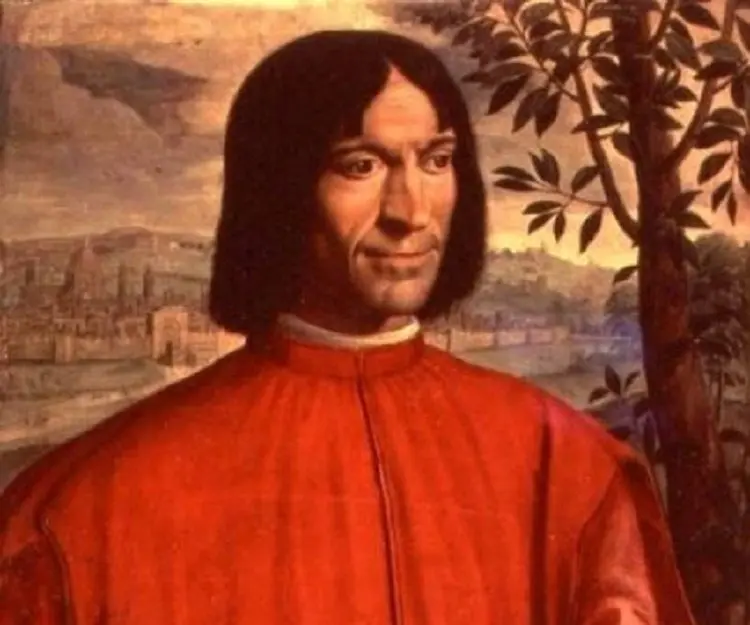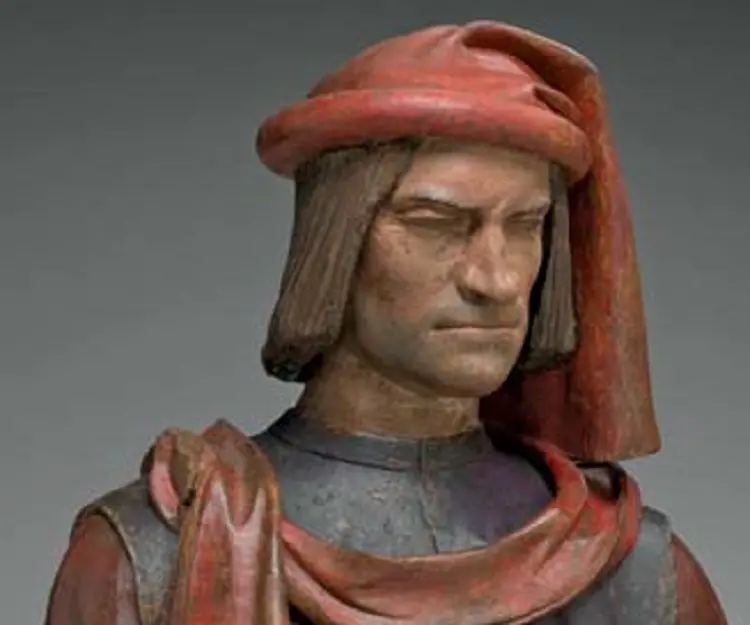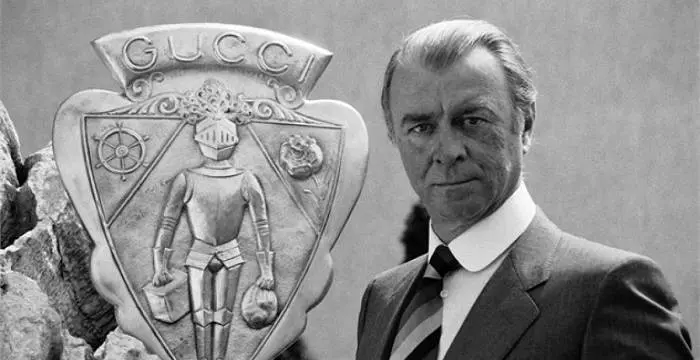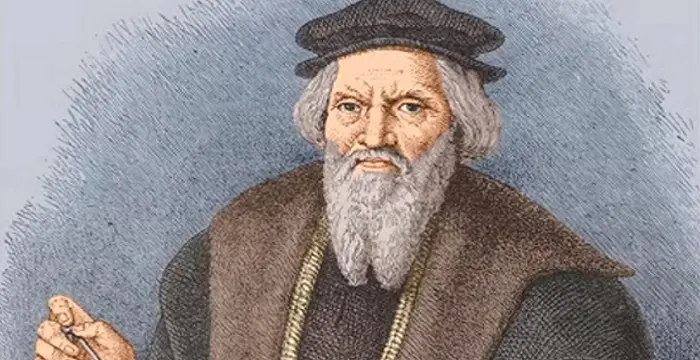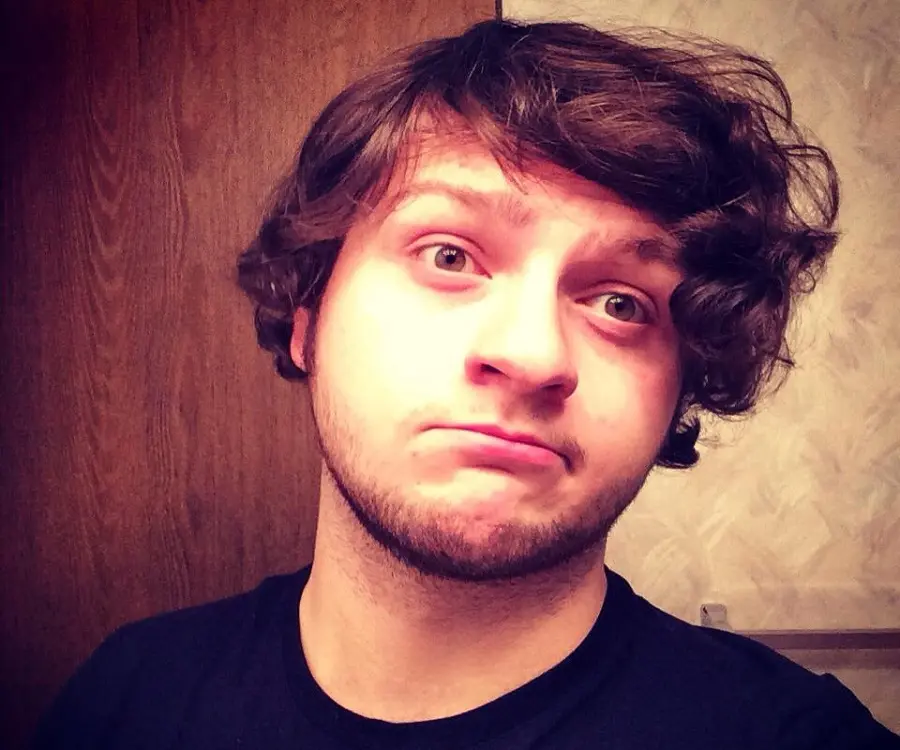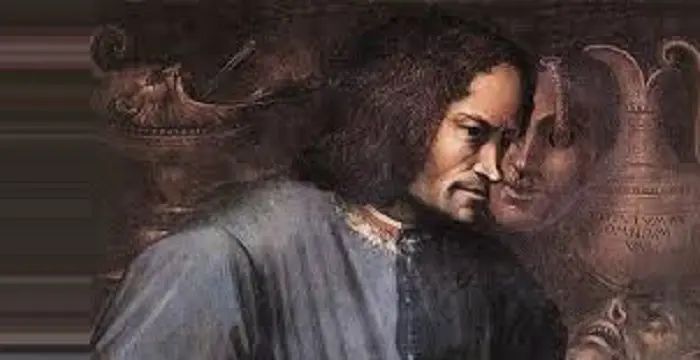
Lorenzo de' Medici - Leaders, Family and Childhood
Lorenzo de' Medici's Personal Details
Lorenzo de’ Medici was an Italian politician, statesman, diplomat, banker, and de facto ruler of the Republic of Florence
| Information | Detail |
|---|---|
| Birthday | January 1, 1449 |
| Died on | April 8, 1492 |
| Nationality | Italian |
| Famous | Leaders, Political Leaders |
| Spouses | Clarice Orsini (m. 1469–1488) |
| Known as | Lorenzo di Piero de' Medici |
| Childrens | Contessina de Médici, Duke of Nemours, Piero the Unfortunate, Pope Leo X |
| Birth Place | Florence, Italy |
| Gender | Male |
| Father | Piero the Gouty |
| Mother | Lucrezia Tornabuoni |
| Sun Sign | Capricorn |
| Born in | Florence, Italy |
| Famous as | Leader |
| Died at Age | 43 |
// Famous Political Leaders
Edi Rama
Edi Rama is the current Prime Minister of Albania. Check out this biography to know about his childhood, life, achievements, works & timeline.
Khalifa bin Zayed Al Nahyan
Sheikh Khalifa bin Zayed Al Nahyan is the current President of the United Arab Emirates (UAE). Check out this biography to know about his birthday, childhood, family life, achievements and fun facts about him.
Leo Varadkar
Cam Leo Varadkar is the current Taoiseach—the Prime Minister—of the Republic of Ireland. Check out this biography to know about his childhood, family life, achievements and other facts about his life.
Lorenzo de' Medici's photo
Who is Lorenzo de' Medici?
Lorenzo de’ Medici, also known as Lorenzo the Magnificent, was an Italian politician, statesman, diplomat, banker and de facto ruler of the Republic of Florence. Considered to be one of the most influential patrons of artists, poets, and scholars during the Italian Renaissance, he ushered in the Golden Age of Florence and funded many public projects in the city. In his youth, he far outshone his siblings and was tutored by a Greek Scholar, a philosopher, and a bishop and diplomat. He equally excelled in physical activities, participating in jousting, hunting, hawking, and breeding horses for Palio di Siena. He entered politics at the age of 16, assuming the familial power over Florence four years later. He employed the same tactics used by his predecessors, ruling the city indirectly and instigating payoffs, threats, and strategic marriages through his associates to maintain absolute control. The Medicis had their own share of enemies, who not only despised them for their wealth and almost tyrannical hold over Florence, but also because they were not elected for this position. Lorenzo was instrumental in forging a tentative alliance with the warring Italian city states, which collapsed soon after his death. He left the Medici bank assets depleted, with the economy already suffering a severe drainage with his grandfather’s ambitious building projects, mismanagement, wars, and political expenses before him.
// Famous Leaders
Edi Rama
Edi Rama is the current Prime Minister of Albania. Check out this biography to know about his childhood, life, achievements, works & timeline.
Tecumseh
Tecumseh was a Native American leader of the Shawnee clan. This biography profiles his childhood, life and timeline.
Khalifa bin Zayed Al Nahyan
Sheikh Khalifa bin Zayed Al Nahyan is the current President of the United Arab Emirates (UAE). Check out this biography to know about his birthday, childhood, family life, achievements and fun facts about him.
Childhood & Early Life
Lorenzo was born on January 1, 1449, in the powerful and wealthy Florentine branch of the Medici family. His parents were Piero di Cosimo de' Medici and Lucrezia Tornabuoni. He had four siblings: sisters Maria, Bianca, and Lucrezia, and brother Giuliano.
His grandfather, Cosimo de’ Medici was a man of vision and aptitude, being the first in his family to helm both the Medici Bank and Florentine government together. His rule was supplemented by his great wealth, a sizeable portion of which was used for administrative purposes and philanthropic initiatives, as well as for endorsing the development of arts and culture in the city state. It made him incredibly popular and consolidated his family’s position.
During his father’s tenure, Piero de Medici, also known as Piero the Gouty, did not actively take part in the governance, both for the lack of interest and poor health, and was content as a patron and collector of arts. His wife, Lucrezia, wrote sonnets and promoted poetry and philosophical discussions. Piero’s brother, Giovanni di Cosimo de' Medici was named their father’s executor but unfortunately predeceased Cosimo. In 1461, Piero became the last Medici to be elected as the Gonfaloniere of Justice.
Lorenzo was said to be an exceptionally intelligent, curious, and witty youth with a refined taste in humanities and culture. The brightest amongst his generation of Medicis, his family made sure that his education augmented his inherent acumen. He was taught by the humanist philosopher Marsilio Ficino and the bishop and diplomat Gentile de' Becchi. The émigré Greek scholar and philosopher John Argyropoulos trained him in Greek.
Lorenzo and Giuliano regularly took part in jousting tournaments, hawking and hunting excursions. They bred horses for races such as Palio de Siena.
By several accounts, Giuliano was more handsome. Lorenzo was a man of medium height, with broad shoulders, short legs. He was of dark complexion and had a squashed nose, a pair of short-sighted eyes, and a harsh voice.
Rise to Power
Cosimo passed away in 1464, and two years after that, Lorenzo entered politics at the age of 16. Piero wisely employed his son’s cunning and wisdom for diplomacy, sending him to meet the Pope and other contemporary European leaders. After his father’s death on December 2, 1469, Lorenzo took the helm of Medici family and ran Florence with the help of Giuliano and Lucrezia as advisors.
Like the rest of his family, Lorenzo did not rule directly but through surrogates in the city council. The greatest criticism levelled against him was that he was virtually a despot and while Florence thrived in his reign, people did not have the merest of political freedom. It inevitably garnered him the resentment from the rival Florentine families who felt they had little to no actual power in the city state.
Alum was an important commodity in several industries like glass-making, tanning, and textile, and most of its sources were in areas under Ottoman control. So when it was discovered in Volterra, the people of the city sought the backing of the Medici Bank. Lorenzo got involved in the city’s mining effort in 1462 or 1463.
But the Volterrans, soon realising the value of the alum mine, organised a rebellion and secession from their Florentine patrons. An infuriated Lorenzo sent an army of mercenaries to the city, who promptly ransacked it. Recognizing his mistake, he rushed to Volterra to correct it, but it would remain the greatest folly of his career.
The leading rivals of the Medicis in Florence were the Pazzi family. On April 26, 1478, Lorenzo and Giuliano were attacked in the Cathedral of Santa Maria del Fiore by a group led by Francesco de' Pazzi, Girolamo Riario, and Francesco Salviati, the Archbishop of Pisa, with encouragement from Pope Sixtus IV himself. The incident came to be known as the ‘Pazzi Conspiracy’.
Giuliano was repeatedly stabbed and bled to death on the cathedral floor. Lorenzo, with the aid of poet Angelo Ambrogini, managed to get away with serious, but not life threatening injuries.
When people heard of the conspiracy, their reaction was brutal. All the conspirators and their many presumably innocent family members were captured and put to death. Some, like Cardinal Raffaele Riario, were saved by Lorenzo’s timely intervention.
Patronage of the Arts
Lorenzo hosted some of the most important and influential artists of his age at his court, including Pollaiuolo brothers, Leonardo da Vinci, Michelangelo di Lodovico Buonarroti, Sandro Botticelli, Domenico Ghirlandaio, and Andrea del Verrocchio. Michelangelo stayed at the Medici household for five years, dining with Lorenzo and his family and taking part in discourses led by Marsilio Ficino.
The Medici library, now known as the Laurentian Library, started from Cosimo’s personal book collection. Lorenzo expanded its cache, sending his agents to retrieve old manuscripts and books. He had them copied and distributed all across Europe. A renowned humanist, Lorenzo was a patron of philosophers who sought to combine Plato’s teachings with Christianity.
A poet in his own right, his works in his native Tuscan celebrated life, love, feasts, and light. He would often turn melancholic in his writings, musing about the fragility and instability of human condition.
Following the footsteps of his father and grandfather before him, Lorenzo spent a huge portion of his fortune on charity, buildings, and taxes, which, in aggregate from 1434 to 1471, amounted to about 663,000 florins. He did not regret it, considering “the money was well-expended”.
Aftermath of the Pazzi Conspiracy
The Pazzi Conspiracy and the subsequent persecution of Sixtus IV’s supporters had grave consequences. The Pope excommunicated Lorenzo and his entire administration, ordered the seizure all Medici assets in Rome and outside, and eventually put Florence under interdict, forbidding mass and communion. He reached out to the traditional military arm of the papacy, King Ferdinand I of Naples, who sent his son, Alfonso II of Naples, to invade the Florentine Republic.
Lorenzo had the support of his people, but from Bologna and Milan, the usual allies of the Medicis, no help was coming. In an unusual and desperate move, Lorenzo travelled to Naples and put himself in the custody of the Neapolitan King. After three months he was released and Ferdinand helped him in brokering a peace treaty with the papacy. He further improved the relationship among various Italian city states to put forth a joint front against outside forces such as France, Spain, and the Ottoman Empire.
Later Years & Death
By the end of his tenure, several branches of the Medici Bank had collapsed due to bad loans and Lorenzo was reduced to embezzling trust and state funds. It was also during this period that Girolamo Savonarola, a Dominican friar who believed that Christians had lost their ways into Greco-Roman culture, became popular in Florence.
Lorenzo died on April 8, 1492, at the family villa of Careggi. He was buried in the Church of San Lorenzo beside his brother.
Personal Life & Legacy
Clarice Orsini, his future wife, was the daughter of Jacopo Orsini and his wife and cousin Maddalena Orsini. The family, based in Rome, was wealthy and belonged to the nobility of the papal court. In an effort to douse the rising hostility between the papacy and the progressive Florence and more importantly, raise their own social status, the Medicis found the perfect prospects for a bride in Clarice.
Lucrezia Tornabuoni travelled to Rome to meet the Orsinis, where her brother Giovanni Tornabuoni, the director of the Roman branch of the Medici Bank, served as the mediator. She questioned Clarice thoroughly. Her inspection, which would seem quite intrusive by modern standards but were quite common back then, must have satisfied her, because she wrote a glowing review of their potential daughter-in-law in a letter to her husband.
Soon after, Lorenzo himself went to Rome and met Clarice. When he gave his approval, the negotiations for the marriage contract began, which would protract for almost a year. Finally, an agreement was reached, and among other details, a dowry of 6,000 florins was stipulated. Lorenzo wed Clarice by proxy on February 7, 1469 and in person on June 4.
However, the marriage did not receive much support from the people of Florence, for whom it was not only a slight on the Florentine humanist movement to marry arguably the most promising and intellectual young man of the city to a religious and introverted woman like Clarice, but also they felt that if the Medicis were truly looking to elevate their social standings through marriage contracts, they should have picked a Florentine woman of noble standing.
To placate his city, Lorenzo decided to introduce his new wife through a jousting tournament held to celebrate his 20th birthday. He even won the tournament, in which the sons of the important families of Florence competed.
The union produced ten children: Lucrezia Maria Romola (born 1470-1553), twins who died immediately after birth (1471), Piero di Lorenzo (1472-1503), Maria Maddalena Romola (1473-1528)), Contessina Beatrice (1474, did not survive infancy), Giovanni di Lorenzo (1475-1521), Luisa (1477-88), Contessina Antonia Romola (1478-1515), and Giuliano de' Medici, Duke of Nemours (1479-1516). Lorenzo also adopted his brother Giuliano’s illegitimate son, Giulio, who later ascended the papal throne as Clement VII.
His most prominent if not only mistress was Lucrezia Donati, the youngest daughter of Manno Donati and his wife, Caterine Bardi. The Donatis were a declining noble family from Florence. According to the most prevalent theory, she met Lorenzo at the wedding of one of his close friends, before his marriage to Clarice. There, Lucrezia, already married to one Niccolo Ardinghelli for three years, apparently gave him a garland of flowers, which she requested him to wear in a joust to show his love for her.
He did just that, as well as carried a banner that had her image on it, crafted by Botticelli. In the following years, they would exchange letters and Lorenzo would write the bucolic poem ‘Corinth’ with her in mind. The affair likely had continued until his death in 1492; however, it did not produce any children.
Piero di Lorenzo, his eldest son, who would be known as Piero the Unfortunate, succeeded him as the head of the Medici family and de facto ruler of Florence. But due to Piero’s feeble, arrogant and undisciplined character, he squandered away his father’s patrimony and almost brought his family to ruin. His brother, Giovanni, who became Pope Leo X, took Florence back in 1512 with the help of a Spanish army and installed another brother, Giuliano, as the ruler of Florence.
In 1529, the Medici rule in Florence was formalised by Pope Clement VII. Alessandro de' Medici, Lorenzo’s great-grandson, became the last member of the senior branch of the Medici family to govern Florence and the first of the city state’s hereditary dukes.
Trivia
English actor Elliot Cowan played Lorenzo in Starz’s historical fantasy drama ‘Da Vinci’s Demons.’
// Famous Italian peoples
Pietro Boselli
Pietro Boselli is an Italian model, engineer, teacher, and fitness athlete who became famous as the ‘world’s sexiest math teacher’. Check out this biography to know about his birthday, childhood, family life, achievements and fun facts about him.
Guccio Gucci
Guccio Gucci was a famous fashion designer from Florence, Italy, and the founder of the world-renowned fashion brand ‘Gucci.’ Check out this biography to know about his childhood, family, personal life, career, etc.
John Cabot
John Cabot was an Italian navigator and explorer who was the first European to discover the coast of North America. Check out this biography to know about his childhood, life, and achievements.
Lorenzo de' Medici biography timelines
- // 1434 To 1471Following the footsteps of his father and grandfather before him, Lorenzo spent a huge portion of his fortune on charity, buildings, and taxes, which, in aggregate from 1434 to 1471, amounted to about 663,000 florins. He did not regret it, considering “the money was well-expended”.
- // 1st Jan 1449Lorenzo was born on January 1, 1449, in the powerful and wealthy Florentine branch of the Medici family. His parents were Piero di Cosimo de' Medici and Lucrezia Tornabuoni. He had four siblings: sisters Maria, Bianca, and Lucrezia, and brother Giuliano.
- // 1461During his father’s tenure, Piero de Medici, also known as Piero the Gouty, did not actively take part in the governance, both for the lack of interest and poor health, and was content as a patron and collector of arts. His wife, Lucrezia, wrote sonnets and promoted poetry and philosophical discussions. Piero’s brother, Giovanni di Cosimo de' Medici was named their father’s executor but unfortunately predeceased Cosimo. In 1461, Piero became the last Medici to be elected as the Gonfaloniere of Justice.
- // 1462 To 1463Alum was an important commodity in several industries like glass-making, tanning, and textile, and most of its sources were in areas under Ottoman control. So when it was discovered in Volterra, the people of the city sought the backing of the Medici Bank. Lorenzo got involved in the city’s mining effort in 1462 or 1463.
- // 1464 To 2nd Dec 1469Cosimo passed away in 1464, and two years after that, Lorenzo entered politics at the age of 16. Piero wisely employed his son’s cunning and wisdom for diplomacy, sending him to meet the Pope and other contemporary European leaders. After his father’s death on December 2, 1469, Lorenzo took the helm of Medici family and ran Florence with the help of Giuliano and Lucrezia as advisors.
- // 7th Feb 1469Soon after, Lorenzo himself went to Rome and met Clarice. When he gave his approval, the negotiations for the marriage contract began, which would protract for almost a year. Finally, an agreement was reached, and among other details, a dowry of 6,000 florins was stipulated. Lorenzo wed Clarice by proxy on February 7, 1469 and in person on June 4.
- // 26th Apr 1478The leading rivals of the Medicis in Florence were the Pazzi family. On April 26, 1478, Lorenzo and Giuliano were attacked in the Cathedral of Santa Maria del Fiore by a group led by Francesco de' Pazzi, Girolamo Riario, and Francesco Salviati, the Archbishop of Pisa, with encouragement from Pope Sixtus IV himself. The incident came to be known as the ‘Pazzi Conspiracy’.
- // 1492He did just that, as well as carried a banner that had her image on it, crafted by Botticelli. In the following years, they would exchange letters and Lorenzo would write the bucolic poem ‘Corinth’ with her in mind. The affair likely had continued until his death in 1492; however, it did not produce any children.
- // 8th Apr 1492Lorenzo died on April 8, 1492, at the family villa of Careggi. He was buried in the Church of San Lorenzo beside his brother.
- // 1512Piero di Lorenzo, his eldest son, who would be known as Piero the Unfortunate, succeeded him as the head of the Medici family and de facto ruler of Florence. But due to Piero’s feeble, arrogant and undisciplined character, he squandered away his father’s patrimony and almost brought his family to ruin. His brother, Giovanni, who became Pope Leo X, took Florence back in 1512 with the help of a Spanish army and installed another brother, Giuliano, as the ruler of Florence.
- // 1529In 1529, the Medici rule in Florence was formalised by Pope Clement VII. Alessandro de' Medici, Lorenzo’s great-grandson, became the last member of the senior branch of the Medici family to govern Florence and the first of the city state’s hereditary dukes.
// Famous Capricorn Celebrities peoples
Weston Koury
All about American social media star Weston Koury, including his age, family life, girlfriends, birthday, and some fun facts.
Elin Nordegren
Elin Nordegren is the ex-wife of Tiger Woods. Check out this biography to know about her childhood, family life, achievements and fun facts about her life.
ItsJustNick
ItsJustNick is a Canadian YouTube star & social media personality. Let’s take a look at his family and personal life including age, date of birth, net worth, girlfriends, and fun facts.
Rudan Custodio
Check out all that you wanted to know about Rudan Custodio, the famous American YouTube Personality; his birthday, his family and personal life, his girlfriends, fun trivia facts and more.
Zahara Jolie-Pitt
Zahara Jolie-Pitt is the adopted daughter of former celebrity couple Angelina Jolie and Brad Pitt. Check out this biography to know about her childhood, family life and fun facts about her.
Adam Dahlberg
Check out all that you wanted to know about Adam Dahlberg, the famous YouTuber and gamer; his birthday, his family and personal life, his wife, fun trivia facts and more.
Lorenzo de' Medici's FAQ
What is Lorenzo de' Medici birthday?
Lorenzo de' Medici was born at 1449-01-01
When was Lorenzo de' Medici died?
Lorenzo de' Medici was died at 1492-04-08
Which age was Lorenzo de' Medici died?
Lorenzo de' Medici was died at age 43
Where is Lorenzo de' Medici's birth place?
Lorenzo de' Medici was born in Florence, Italy
What is Lorenzo de' Medici nationalities?
Lorenzo de' Medici's nationalities is Italian
Who is Lorenzo de' Medici spouses?
Lorenzo de' Medici's spouses is Clarice Orsini (m. 1469–1488)
Who is Lorenzo de' Medici childrens?
Lorenzo de' Medici's childrens is Contessina de Médici, Duke of Nemours, Piero the Unfortunate, Pope Leo X
Who is Lorenzo de' Medici's father?
Lorenzo de' Medici's father is Piero the Gouty
Who is Lorenzo de' Medici's mother?
Lorenzo de' Medici's mother is Lucrezia Tornabuoni
What is Lorenzo de' Medici's sun sign?
Lorenzo de' Medici is Capricorn
How famous is Lorenzo de' Medici?
Lorenzo de' Medici is famouse as Leader




